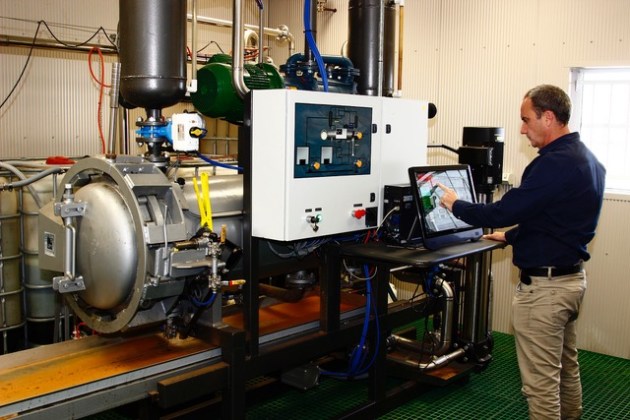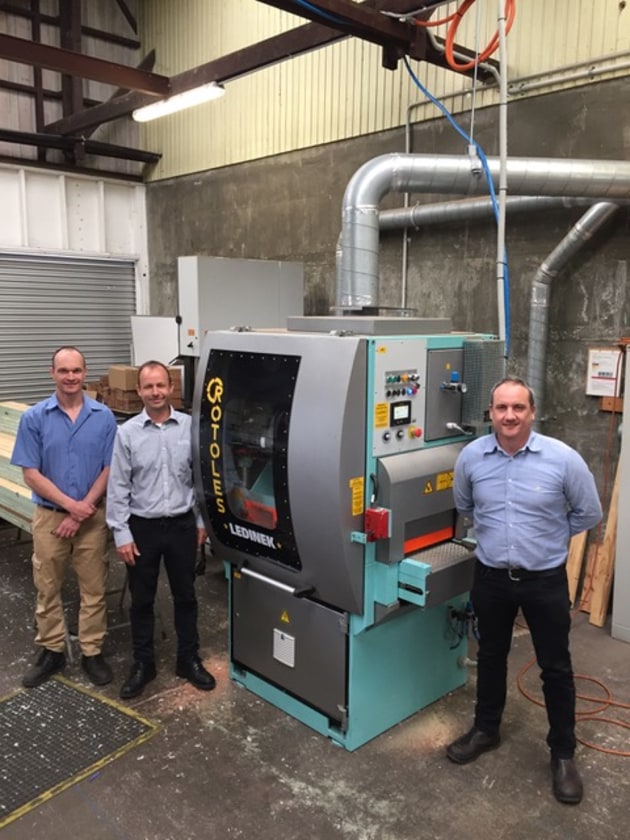Australia’s one and only wood science ‘theme park’
Above: Bill Leggate, team leader, operates the experimental timber preservation plant.
Words and photos: Jim Bowden
We have just revisited ‘Wood World’ – a science technology ‘theme park’ that has become the epicentre of Australia’s research into wood products and processing. Covering two hectares on the outskirts of Brisbane with more than 3100 sqm of machine shops, laboratories and offices, the Salisbury Research Facility indeed has a global perspective.
The team continues to gain strength, with a staff of timber engineers, wood and forestry scientists and technicians. They are also linked to a network of institutions –Timber Queensland, the Engineered Wood Products Association of Australasia, Queensland University of Technology, University of Queensland, Griffith University, University of Sunshine Coast, Australian National University and the University of Tasmania, to name just a few.
But their wood science skills and exchange of knowledge reaches further – to New Zealand, France, Switzerland, Germany, the US, Brazil, Indonesia, Vietnam, Laos and Fiji.
The Queensland government has been conducting forest product research and development since the early 1900s. Today, the forest products innovation team sits within horticulture and forestry science alongside the forest production and forest protection group. The ‘wood world’ tour was conducted by Dr Rob McGavin, research facility and project manager within the Department of Agriculture and Fisheries’ agri-science division. To say he was bursting with pride as he introduced a plethora of key projects completed or under way would be an understatement. He took on the task of capsulising some of them – engineered wood composites, product design, kiln drying, sawmilling, veneer processing, grading, wood properties evaluation, performance testing, timber protection and wood extractive analysis.
Looking over a Ledinek Rotolas rotary planing machine at the Salisbury Research Facility are Andrew Outhwaite, senior adhesives technician, Dr Rob McGavin, research facility and project manager, and Bill Leggate, team leader.
“But this is my latest toy,” he said as he unlocked a side panel and started pushing buttons on a rotary planer from Europe. Dr McGavin says he ‘discovered’ an earlier version of the machine at the LIGNA machinery fair in Germany in 2001 and never forgot it. “We were looking for alternative methods to prepare boards to improve gluing and face milling continuously showed promise and the investment was made in 2019,” he said.
Adhesion research has been a more recent expansion for the Salisbury team. “With the growing international demand for engineered wood products, Queensland industry is well placed to provide new value-added products with some key advantages over most commonly available timber species,” Dr McGavin said. “These include higher mechanical performance and superior natural durability. But some of Queensland’s timber can be challenging to bond.”
He said a key to accessing these emerging markets was the matching of adhesive systems and the manufacturing protocols to ensure glue bonds were strong and durable. It provided a different approach to conventional planers and was showing real benefits in boosting bond performance.
One project that captured attention against a background of a diminishing wood resource was the performance of early-age tropical and sub-tropical plantation eucalypts in veneer-based engineered wood products. New spindleless veneer lathe technology has optimised the processing of the hardwood resource; grade quality and recovery have been determined across a number of priority species.
Adhesive performance using a range of adhesives has been conducted at a laboratory and semi-production scale. Plywood and LVL products have been manufactured and multiple construction strategies tested. Mechanical properties have been determined for each species. Results clearly indicate that the early-age hardwood plantation resource, previously thought to be unusable, can be processed with suitable systems to yield valuable structural grade veneer.

Jack Dorries, research assistant, measures the wettability of timber as part of the adhesion development program.
Studies have also involved early, mid and final rotation age plantation hardwoods including spotted gum, Gympie messmate, red mahogany, Dunn’s white gum, western white gum, blue gum and shining gum, opening the door for new, more productive and sustainable forest management approaches.
A cross-section of plantation softwood logs was assessed using a range of methods to better measure board quality on green-off-saw boards and kiln-dried boards.
Results from laser measuring devices, vibration, ultra-sound, black and white tonal colour cameras and stress graders were analysed. The results will give the structural pine industry an early assessment and segregation of timber based on indicators for grade quality. This will allow the processor to divert non-structural material early in the process and avoid cost-adding processes such as kiln drying.
Another softwood-focused project aims to determine individual board quality before the tree is even felled. Research at the centre has also focused on ‘hybrid poles’ as Australia faces a critical shortage of timber poles. Plantation thinnings or regrowth stems can be bolted to a steel spike in a cluster to form a hybrid steel wood pole. This has many advantages over options such as steel and concrete, using traditional lightweight timber, a non-conducting material.
Believe me, we have only touched the surface of what’s going on at Salisbury.
Jim Bowden is Managing Editor at Timber & Forestry News.



